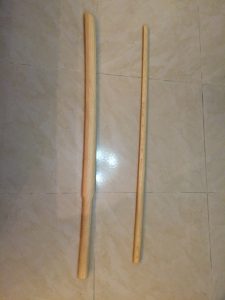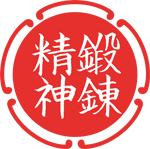Before starting this article I would like to make it clear that Furibo (or sword in general) is not taught as such in Aunkai classes, and I personally never saw a class where they were used. However the spirit of the sword is present and there are often references to it. Emmanuel Frere, one of the French instructors mentioned the Furibo as a very interesting tool on his blog a while ago and I finally ended up getting a relatively light one (1kg) to start.
In my opinion, the Furibo complements the Rokushakubo extremely well. When the Bo is excellent to approach an horizontal transfer of forces, in particular via Tsuki, the Furibo is a superb tool when it comes to understanding how the weight goes into the body on vertical movements, the same way as in Age Te and Sage Te, but without needing a partner. With that in mind, going fast and doing thousands of cuts is not only unnecessary but potentially counter-productive and I’d prefer a slow approach with less repetitions with a focus on finding the point when the weight of the weapon “disappears” as it becomes part of the body.
The weight question is  key when it comes to choosing a weapon for tanren. I personally chose to start light to avoid injuries (risks exist for tendons, especially on the elbows, but also for the back), but a 2-3kgs Furibo can be a good option for people stronger physically than I am. In my opinion, the most important is to avoid transforming these exercises to strengthen our superficial muscles but rather using them to complement our other body conditioning exercises using the same principles, building a relaxed and connected body that can let forces go one way or another.
key when it comes to choosing a weapon for tanren. I personally chose to start light to avoid injuries (risks exist for tendons, especially on the elbows, but also for the back), but a 2-3kgs Furibo can be a good option for people stronger physically than I am. In my opinion, the most important is to avoid transforming these exercises to strengthen our superficial muscles but rather using them to complement our other body conditioning exercises using the same principles, building a relaxed and connected body that can let forces go one way or another.
In addition to the Furibo, I also like using a light bokken (Jikishinkage Naginata Yo), a model I particularly appreciate because its lightness makes straight cuts more difficult to perform and any tension in the body is immediately visible.
In terms of exercises, my focus is on solo training : slow suburi from a Maho position, Shintaijuku, but also a couple of tanren I used to do in Hankumdo in Korea. All of them aim to connect the myofascial layers and create a unified body.

